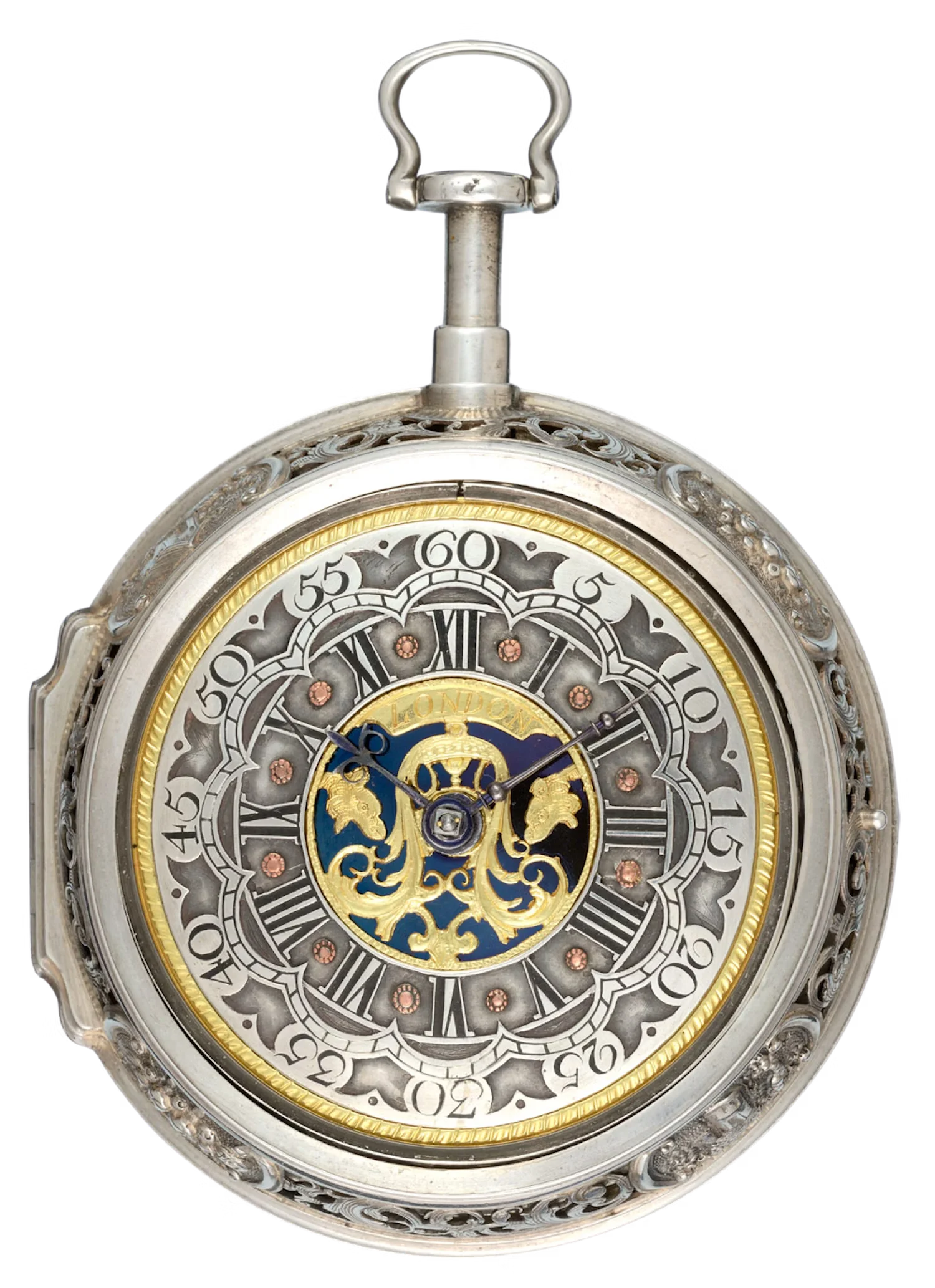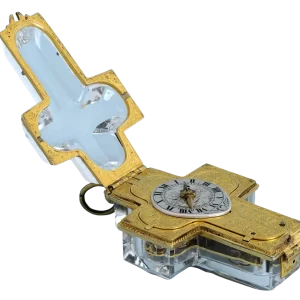ΑΓΓΛΙΚΟ ΡΟΛΟΙ ΤΣΕΠΗΣ - 1660
Υπογραφή Peter Bell Λονδίνο
περίπου το 1660
Εκτός αποθέματος
£5,480.00
Εκτός αποθέματος
Το ρολόι τσέπης ENGLISH CLOCKWATCH του 1660 είναι ένα εκπληκτικό παράδειγμα ωρολογοποιίας των μέσων του 17ου αιώνα, σχολαστικά σχεδιασμένο και εκτελεσμένο στην εντέλεια. Εγκιβωτισμένο σε επιχρυσωμένες μεταλλικές κάσες, αυτό το ρολόι τσέπης με ακμή παρουσιάζει έναν μηχανισμό με βαθύ φινίρισμα από επιχρυσωμένο φινίρισμα και πέντε κολόνες, συμπεριλαμβανομένων δύο πρώιμων αιγυπτιακών κολόνων με μικρές στοές, που αντανακλούν την περίπλοκη τέχνη της εποχής. Ο μηχανισμός φλουζιού και αλυσίδας, με διάταξη κοχλία και κοχλία, είναι έξυπνα τοποθετημένος ανάμεσα στις πλάκες, ενώ ο μηχανισμός κρούσης για ώρες αντηχεί μέσα από ένα κουδούνι που βρίσκεται στο πίσω μέρος της κάσας. Ο ασημένιος τροχός μέτρησης, χαραγμένος με αραβικούς αριθμούς, υποδεικνύει κομψά την τελευταία ώρα που χτυπήθηκε, συμπληρωμένος από έναν μεταγενέστερο τρυπημένο και χαραγμένο κόκορα με ένα μικρό πόδι στον ζυγό. Ο απλός ατσάλινος ζυγός και το μπλε ατσάλινο σπειροειδές ελατήριο, μαζί με τον ασημένιο δίσκο ρυθμιστή, αναδεικνύουν την ακριβή μηχανική της εποχής. Διακοσμητικά στοιχεία, όπως οι περίτεχνα τρυπημένες και χαραγμένες μπλε ατσάλινες πύλες και ο χαραγμένος κύλινδρος, συνδυάζουν άψογα τη μορφή και τη λειτουργία. Το λευκό σμάλτο καντράν, διακοσμημένο με λατινικούς αριθμούς και χρυσούς δείκτες σε σχήμα σκαθαριού και πόκερ, υποστηρίζεται από μια διακοσμητικά χαραγμένη πλάκα καντράν με κοντά περιστρεφόμενα πόδια. Υπογεγραμμένο από τον Peter Bell από το Λονδίνο, αυτό το εξαιρετικό ρολόι, κατασκευασμένο γύρω στο 1660, ενισχύεται περαιτέρω από ειδικά κατασκευασμένες τρυπημένες και χαραγμένες επιχρυσωμένες μεταλλικές κάσες με εσωτερικό κουδούνι, καθιστώντας το ένα πραγματικό αριστούργημα ιστορικής σημασίας και αισθητικής ομορφιάς.
Πρόκειται για ένα εκπληκτικό αγγλικό ρολόι ρολογιού των μέσων του 17ου αιώνα, το οποίο στεγάζεται σε επιχρυσωμένες μεταλλικές κάσες. Ο μηχανισμός είναι όμορφα κατασκευασμένος με βαθύ φινίρισμα από επιχρυσωμένη φινίρισμα και πέντε κολόνες, συμπεριλαμβανομένων δύο πρώιμων αιγυπτιακών κολόνων με μικρές στοές. Το φουζί και η αλυσίδα διαθέτουν σύστημα κοχλία και τροχού που βρίσκεται ανάμεσα στις πλάκες, και ο μηχανισμός κρούσης για τις ώρες περνάει σε ένα κουδούνι που βρίσκεται στο πίσω μέρος της κάσας. Ο ασημένιος τροχός μέτρησης είναι χαραγμένος με αραβικούς αριθμούς που υποδεικνύουν την τελευταία ώρα που χτυπήθηκε, και υπάρχει ένας μεταγενέστερος διάτρητος και χαραγμένος κόκορας με ένα μικρό πόδι που βρίσκεται στον ζυγό. Ο ίδιος ο ζυγός είναι από απλό ατσάλι και το ελατήριο είναι μια μπλε ατσάλινη σπείρα. Ο δίσκος του ρυθμιστή είναι ασημένιος. Οι περίτεχνα διάτρητες και χαραγμένες μπλε ατσάλινες πύλες και ο χαραγμένος κύλινδρος στήριξης παρέχουν διακόσμηση και λειτουργικότητα. Το λευκό σμάλτο καντράν διαθέτει λατινικούς αριθμούς και χρυσούς δείκτες σκαθαριών και πόκερ. Η πλάκα του καντράν είναι διακοσμητικά χαραγμένη και υποστηρίζεται από κοντά περιστρεφόμενα πόδια. Αυτό το ρολόι-ρολόι φέρει την υπογραφή του Peter Bell από το Λονδίνο και κατασκευάστηκε γύρω στο 1660. Οι ειδικά κατασκευασμένες τρυπημένες και χαραγμένες επιχρυσωμένες μεταλλικές κάσες, με εσωτερικό κουδούνι, ολοκληρώνουν την εξαιρετική ομορφιά αυτού του κομματιού.
Υπογραφή Peter Bell Λονδίνο
περίπου το 1660











